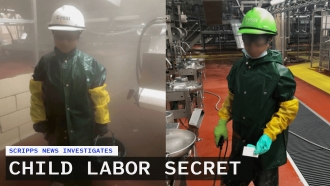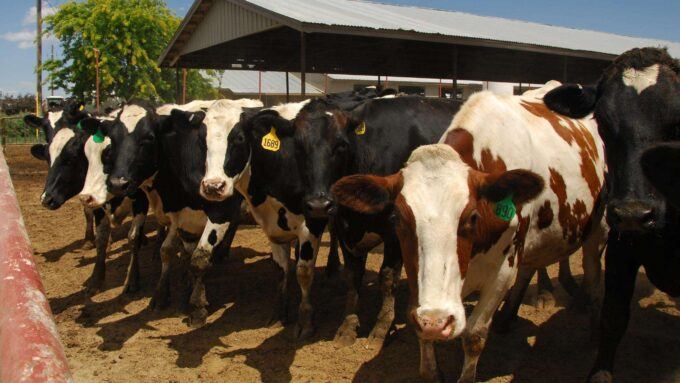Scripps News investigates child labor on farms, one of the least restricted and most dangerous places for kids to work.
Zach Cusson / Scripps News
By Patrick Terpstra and Karen Rodriguez and Zach Cusson
A pint of blueberries begins its journey to the neighborhood grocery store in a field like many others found on thousands of acres in southeast North Carolina.
The fruit thrives on bushes growing in the acidic, black, sandy soil near the Atlantic coast.
At the beginning of each summer, clusters of farmworkers race to pick the berries at their sweetest during a season that lasts just two months.
A Scripps News investigation found children as young as 6 years old are helping to harvest one of America's favorite superfoods.
The discovery comes years after the U.S. Department of Labor fined six North Carolina blueberry farms in 2009 for violating child labor laws, according to federal Wage and Hour Department enforcement records reviewed by Scripps News.
Those records show no documented cases of underage work on blueberry farms in the state since 2017, even as the Labor Department reports a surge of illegal child labor across industries in recent years.
Scripps News met a mother who says two of her three children, ages 6 and 8, work alongside her picking blueberries at a North Carolina farm.
The mother agreed to share their story in the privacy of her rented home and requested her family not be identified out of fear of retaliation.
The mother said they are undocumented immigrants from Guatemala, and that her two children, a 6-year-old daughter and 8-year-old son, began picking blueberries when school let out for summer.
Her daughter stands beside her with small feet still caked in dirt from a day in the fields.
"I take them to work because my husband isn't in good health and is sick," the woman said in Spanish. "He went two or three months without working and we needed to pay rent."
The mother said on the farm she can also watch her kids while they help make ends meet.
Her son began working with her in sweet potato fields two seasons ago at the age of 6, she said. "It is sad because a child shouldn't have to work," she said.
Estimating how many kids are working in similar blueberry fields is difficult.
Many farms are fenced off or have towering "no trespassing" signs posted to keep visitors away.
And Scripps News confirmed that the North Carolina Department of Labor tracks child labor complaints, but not for farm jobs. North Carolina is one of 17 states that exempts agriculture from child labor laws.
Young children working on farms spans generations, said Yessie Bustos, a leader of the nonprofit Student Action with Farmworkers based in Durham, N.C.
"I think it goes back to the fact that farmworkers are not entitled to a fair minimum wage, so they're getting paid by the piece," Bustos said. "That's kind of why you will see a lot of family members out there in the fields, because you need to be able to at least make enough money to provide for the family."
Bustos, 30, recalls picking blueberries herself as a 12-year-old in Michigan.
"For our family, it was a way for us to supplement income," she said.
She looked at a photo shared by the mother of her 8-year-old blueberry worker son, bucket in hand.
"I think of my inner self, like my inner child at the time, not really knowing why I'm doing this, just knowing I have to," Bustos said.
Research from the federal government says about half a million children, age 17 and under, are working on American farms.
A Scripps News investigation discovers a failed effort to stop child labor among young immigrants in rural Minnesota.
"It's backbreaking labor," said Reid Maki, director of child labor advocacy for the National Consumers League and the Child Labor Coalition.
He has long pressed for stronger federal protections for kids in agriculture.
"We have a copy machine around the corner here in the office, and I can't bring in a 12-year-old nephew to work on that copy machine, but that same child can be put on a farm and work 12- or 14-hour days," Maki said.
Federal law allows youth as young as 12 to work in agriculture if they have their parents' consent and it's not during school hours.
There also are exceptions that allow children of any age to work on a farm owned by a parent or on other "certain very small farms" outside of school hours, according to a statement from the Wage and Hour Division of the U.S. Department of Labor.
A Labor Department spokesman declined to answer whether the farm where the mother said she works with her children was violating any child labor laws.
Earlier this year the Biden administration announced a crackdown on employers hiring kids to work dangerous jobs in other industries, fining contractors illegally employing teens to clean meatpacking plants in the dead of night.
There has not been the same sweeping action targeting agriculture.
A Scripps News investigation found suspicions of child labor went back years before authorities took action against a Nebraska meatpacking plant.
"Monitoring the millions and millions of acres of U.S. farms is difficult," Maki said. "It's not impossible, though. I think that may be the case that they really could focus more on dangerous jobs."
A farm is a dangerous place to work, especially for minors.
One federally funded research study found about 33 children get hurt working on U.S. farms every day.
In 2018, a report from the federal Government Accountability Office found the "majority of work-related child fatalities were in agriculture" even though "agriculture employs a small percentage of working children."
The mother of the two young children helping with the blueberry harvest this summer said they sometimes complain about the summer heat.
"Yesterday my daughter had a lot of headaches," the mother said. "Last night she was complaining that her head hurt and she couldn’t stand it."
Bustos remembers the danger of heavy farm machinery.
"The example I always share is, I learned how to drive a blueberry picking machine before I even learned how to drive a vehicle," she said. "The thing is like three or five times the size of a regular car. They're huge."
Bustos and other advocates for farmworkers are pressing Congress to bring rules for employing minors on farms in line with other industries.
The CARE Act would raise the minimum age for work on commercial farms to 14 years old, while adding restrictions for all minors who work in agriculture.
It has not gained traction on Capitol Hill despite years of efforts to get it passed.
Bustos estimates there is a 50-50 chance children have had a hand in harvesting a typical pint of blueberries purchased by consumers.
"They should ask themselves, how are we putting them in a position where that's the only way to make ends meet?" she said.
After a day of work, the 8-year-old boy who goes to the blueberry fields still finds time to play.
He shows off his collection of Matchbox cars and, behind the house, his family’s pet chickens and turtles.
His mother said she sees education as a way for their children to eventually leave farm work behind them.
"I always tell my kids, first give thanks to God, and I tell them, I want you to take advantage of your time at school," the boy’s mother said. "I take them to the fields so they realize what working the fields is like and so they work harder in school."
They are lessons that come from a life of hard work beginning at a tender age.
Data analysis by Daniel Lathrop and Rosie Cima



